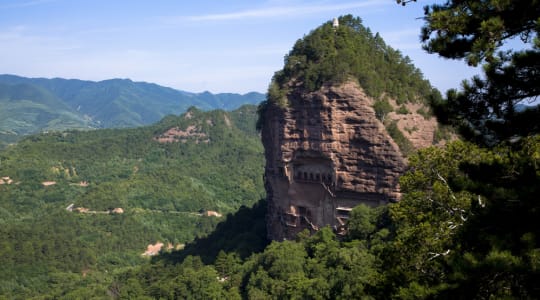
Maijishan Grottoes is a Buddhist cave temple complex located in Tianshui, Gansu Province, China. It is situated on a rocky hill about 35 meters high and covers an area of about 1.2 hectares. The name Maijishan means "wheat stack mountain" in Chinese, due to the similarity of the mountain's shape to a pile of wheat.
The grottoes were built during the Later Qin dynasty (384-417 CE) and expanded during the Northern Wei dynasty (386-534 CE). There are a total of 194 caves and niches, which contain over 7,000 Buddhist statues, carvings, and frescoes. The grottoes are known for their unique style, which blends Indian, Central Asian, and Chinese influences.
The main cave, called the Shiku Temple, is the largest and most ornate. It contains a 16-meter-high seated Buddha statue, which is the largest of its kind in the world. The statue is surrounded by smaller figures of bodhisattvas, arhats, and other Buddhist deities. Other notable caves include the Guanyin Cave, which contains a statue of the bodhisattva Guanyin, and the Five-Bodhisattva Cave, which contains five seated bodhisattva statues.
Maijishan Grottoes is also known for its beautiful natural scenery, including waterfalls, streams, and forests. It has been designated as a National Key Cultural Relics Protection Unit and a National Scenic Area. It is an important site for the study of Chinese Buddhist art and culture, and attracts numerous tourists and scholars from around the world.
Explore Near Maijishan Grottoes
Discover 5 cities and 2 airports within 75km. Perfect for planning day trips, finding connecting flights, or discovering new destinations to explore during your visit.
Nearby Cities Worth Exploring
5 destinations within 26.1km - 71.7km from your location
Airports Near Maijishan Grottoes
2 destinations within 26.5km - 65.5km from your location
Cross-Border Adventures Near Maijishan Grottoes
Discover cross-border adventures near Maijishan Grottoes. Explore neighboring countries with similar attractions and extend your travel experience across borders.








And 8 more neighboring countries